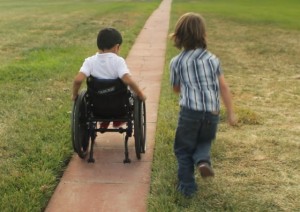
Teaching your child to be inclusive in and out of daycare
The daycare is more than likely the first place your child will get a taste for the kinds of interactions waiting for them when they enter the broader educational system and later on, the real world . Research has shown that pairing children with and without disabilities in these settings early is good for both groups and the old idea that special education means separate education is becoming a thing of the past. This same body of research has shown us that just placing these two groups of children together doesn’t necessarily lead to positive outcomes—proper inclusion needs to be fostered with the right levels of commitment, planning and support. Here’s some things you can do to start that process off right.
It should be no surprise that parents play an active role in teaching their children everyone should be treated equally and have the same opportunities. Teaching your son or daughter the proper way to carry out these goals starts with Mom and Dad using the right language. When they hear you referring to any child as the one with special needs, they might pick up on the fact there is something different they need  to pay attention to. Using “people first” is the right method here, so that “ little girl with autism” simply gets called “Sally” or whatever her name happens to be. Remember, it’s never too early to start letting your children know that everyone does things differently. Being around playmates of different cultures and abilities helps them to appreciate diversity.
to pay attention to. Using “people first” is the right method here, so that “ little girl with autism” simply gets called “Sally” or whatever her name happens to be. Remember, it’s never too early to start letting your children know that everyone does things differently. Being around playmates of different cultures and abilities helps them to appreciate diversity.
The Golden Rule Works
Sometimes, the most modern politically correct thinking meets more traditional ideas and it’s always good to stress The Golden Rule about treating others the way you’d want to be treated. While daycare centers have their place in cultivating these ideals, Mom and Dad can go a long way to foster this particular notion by encouraging their child to play with other children with disabilities. It’s important to come up with innovative ways to accommodate the child with challenges here and toys can be one of the perfect ways to accomplish this goal. The best of these can get children to answer questions or respond to clues together. Great toys promote social behavior and should initiate conversation between two or more children.
Peers With Autism
Preparing your child for any interactions they are going to have with disabled children is another good idea. For example, when they understand their peers with autism might not make eye contact or may suffer through a series of repetitive motions, they will be more understanding when they come across these behaviors.
Keep in mind children might not come with instruction booklets, but they do come with open minds. That means it’s good to start teaching your children about inclusiveness early since by the age of three, they begin to notice the differences in people and the labels we apply to these groups.
Read more info like this at All My Children.
Author: Rob Starr